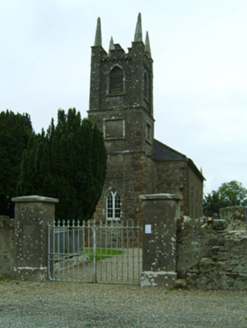Survey Data
Reg No
15702212
Rating
Regional
Categories of Special Interest
Architectural, Artistic, Historical, Scientific, Social
Original Use
Church/chapel
Date
1810 - 1820
Coordinates
316018, 140591
Date Recorded
14/08/2007
Date Updated
--/--/--
Description
Detached three-bay double-height single-cell Board of First Fruits Church of Ireland church, built 1815, on a rectangular plan; single-bay three-stage tower to entrance (west) front on a square plan. Renovated, 1877, with interior "restored". Now disused. Pitched slate roof with clay ridge tiles, cut-granite coping to gables including cut-granite coping to gable (east) on cut-granite diagonal obelisk pinnacle-topped kneelers with cut-granite diagonal obelisk pinnacle to apex, and replacement uPVC rainwater goods on cut-granite eaves retaining cast-iron octagonal or ogee hoppers and downpipes. Roughcast battered walls with benchmark-inscribed rusticated cut-granite quoins to corners; part slate hung surface finish (east); repointed coursed rubble stone surface finish (tower) with lichen-spotted cut-granite stringcourses including lichen-spotted cut-granite stringcourse (bell stage) supporting cut-granite diagonal obelisk pinnacle-topped piers to corners framing crow stepped battlemented parapets having cut-granite coping. Pointed-arch window openings with cut-granite sills, timber Y-mullions, and lichen-spotted cut-granite monolithic surrounds framing timber fittings having cast-iron lattice glazing bars. Pointed-arch window opening (east) with cut-granite sill, interlocking timber Y-mullions, and cut-granite monolithic surround framing timber fittings having cast-iron lattice glazing bars. Pointed-arch window opening (tower) with cut-granite sill, timber Y-mullion, and lichen-spotted cut-granite monolithic surround framing four-over-four timber sash windows having Y-tracery glazing bars. Square-headed blind openings (second stage) with cut-granite sills, and lichen-spotted cut-granite monolithic surrounds framing rendered infill. Pointed-arch openings (bell stage) with cut-granite sills, and lichen-spotted cut-granite monolithic surrounds framing louvered fittings. Set in landscaped grounds on a corner site with lichen-spotted rendered, ruled and lined piers to perimeter having cut-granite shallow pyramidal capping supporting arrow head-detailed wrought iron double gates.
Appraisal
A church erected with financial support from the Board of First Fruits (fl. 1711-1833) representing an important component of the early nineteenth-century ecclesiastical heritage of County Wexford with the architectural value of the composition, one recalling the contemporary Saint Busk's Church (Templescoby) (1817) in Templescoby (see 15702546), confirmed by such attributes as the standardised nave-with-entrance tower plan form, aligned along a liturgically-correct axis; the "pointed" profile of the openings underpinning a Georgian Gothic theme with those openings showing pretty lattice glazing patterns; and the slender pinnacles embellishing the tower as a picturesque eye-catcher in the landscape. Having been reasonably well maintained, the elementary form and massing survive intact together with substantial quantities of the original fabric, both to the exterior and to the interior, including a partial slate hung surface finish widely regarded as an increasingly endangered hallmark of the architectural heritage of County Wexford: meanwhile, contemporary joinery 'supplied by Messrs. Jones and Son [of] Wexford'; a restrained wall monument commemorating Isabella Armstrong (née Fothergill) (1805-51); and 'a handsome oak lectern presented by William Bolton [1815-1905] of The Island in memory of his father and mother' (Irish Builder 1st January 1878, 4), all highlight the artistic potential of a church making a pleasing visual statement in a rural street scene.

